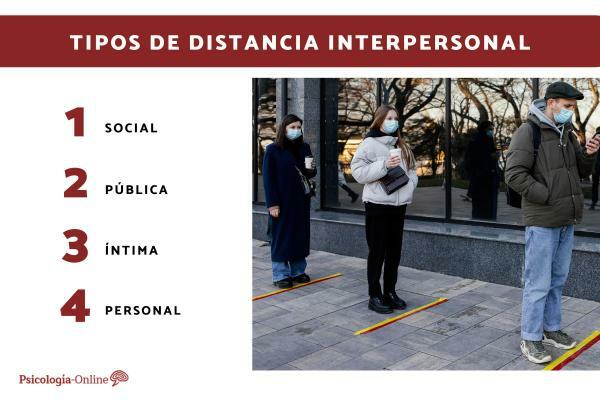
Interpersonal distance corresponds to maintaining a physical and emotional distance from some people. This concept, coming from the study of human communication, can be related to motives that differ depending on the context and the situations that the person has experienced. Putting a distance is usually associated with setting clear and notorious limits that can affect the ties that a human being has. Given this, the theme has some subtleties that represent changes in the modality of contemplating actions, since the emotions and thoughts that are put into play have a fundamental role. There are several ways to mark a distance with other people if a decision of this caliber is reached.
In this Psychology-Online article we will provide you with information about the types of interpersonal distance.
Index
- What is proxemics or interpersonal distance
- social distance
- public distance
- intimate distance
- personal distance
What is proxemics or interpersonal distance.
Proxemics or interpersonal distance is the study of perception of physical space in social interaction. This concept was addressed by the anthropologist Edward Hall, who tried to understand the verbal and non-verbal communication that occurred between human beings in social settings. In this way, it was possible to build a firm theoretical base to think about the modalities that are put into play between people.
On the one hand, proxemics or interpersonal distance takes into account emotions, thoughts and behaviors in a particular way, in order to understand each person. On the other hand, this concept emphasizes the group aspects that arise from physical contact.
Distancing will depend on the space of a given social situation, which will allow it to be classified into intimate, personal, social, and public distance. Below we will explain each of them.
Social distance.
Social distance refers to space that is produced to delimit the contact physically and/or emotionally with other people in social situations. The intensity and frequency of this type of distance will depend on the qualities that the person has. If reference is made to physical contact, the average social distance ranges between 1.25 and 2 meters in periods of closeness, while in moments of distance it is 2 to 3.5 meters.
One of the most notorious examples of this condition we could observe during the social distancing that was implemented in the COVID-19 pandemic to prevent the spread of infections. In this article we explain How has Covid-19 impacted people's mental health?.

Public distance.
Public distance is a concept used to address those social situations in which there is little contact physical and emotional. This idea corresponds to the fact that the person decides to maintain a distance even greater than that included in the social distance, which results in a notorious lack of closeness.
According to Hall, public distance has two types of stages: the near and far phase. In the first, the distance ranges between 3.5 and 7.25 meters. On the other hand, in the distant phase it is greater than 7.25 meters. In other words, these are sporadic interactions in which there is no lasting dialogue between people.
Some examples of situations where we may find public distancing include press conferences, book launches, concerts, etc.
intimate distance.
The intimate distance represents the space between people in intimate situations. As its name indicates, these are moments linked to extremely close physical and/or emotional contact with the participation of the bodily senses.
In more concrete terms, it is common for aspects related to vision, smell, touch, hearing and taste to come into play. Taking Hall's contributions as a reference, the next phase oscillates between 0 and 15 centimeters. In this aspect, the distant phase is around 15 and 45 centimeters in length.
The situations in which we can find an intimate distance correspond to those that offer the possibility to maintain great closeness between people, as is the case with hugs and intimate encounters sexual.
Personal distance.
Finally, personal distance refers to the spaces of each human being that are formed in a social interaction. However, the most outstanding aspect is that direct contact can be established between people by using different areas of the human body.
According to the investigations carried out on this subject, the next phase is located between 45 and 75 centimeters. In the same direction, there is the far phase that oscillates between 75 centimeters and 1.25 meters away.
One of the everyday situations that reflects these parameters is represented in public conversations between friends and relatives, since a space that each person marks persists.

This article is merely informative, at Psychology-Online we do not have the power to make a diagnosis or recommend a treatment. We invite you to go to a psychologist to treat your particular case.
If you want to read more articles similar to Types of interpersonal distance, we recommend that you enter our category of Clinical psychology.
Bibliography
- Edeso Natalías, V. (2005). Social distance and its importance in interaction: proposal for its study in the ELE class. Zaragoza's University.
- Gordillo León, F., López Pérez, R.M., Mestas Hernández, L., Corbi Gran, B. (2014). Non-verbal communication in negotiation: the importance of knowing how to express what is said. Electronic Journal of Psychology Iztacala, 17 (2), 646-666.


